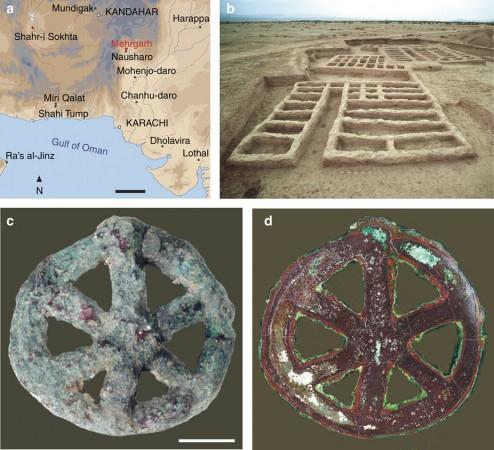
Archaeologists have finally unearthed the secrets of a 6000-year-old amulet, which was discovered three decades ago in 1985 from Mehrgarh, a Neolithic site located in Balochistan, a region in western Pakistan.
This amulet looks like an asymmetrical wheel, which is green coloured, which is caused by corrosion. This is believed to be one of the oldest objects crafted using lost wax casting due to its asymmetrical appearance.
Previously the researchers only guesstimated this amulet to be created using lost-wax casting, due to lack of proof, but now with the help of technology they revealed various facts about this little six-millennium old, ancient amulet.
An imaging technique termed 'photoluminescence' was used to carry out crucial details about the amulet by observing it at a microscopic level. This object was exposed to strong light by the researchers and it was found that light was reflected from the atoms and electrons that this six-millennium old amulet comprised.
This led to the finding that, the alloying element used to create this amulet was found to be copper. The interior of the amulet portrayed numerous little bristle-like rods of copper oxide spread throughout.
But unlike the structures possessed by other copper-oxygen compounds, the structure found in the amulet was dissimilar. This is said to be a result of exposure to prolonged period of corrosion.
"We discovered a hidden structure that is a signature of the original object, how it was made," stated lead author Mathieu Thoury, a physicist at Ipanema, the European center for the study of ancient materials, as quoted by the Washington Post.
"You have a signature of what was happening 6,000 years ago," Thoury added.
The lost-wax casting technique used to create this amulet consists of the following five steps:
- The replica of the object to be created is crafted in wax.
- This is followed by creating a mould surrounding the object
- This mold is then heated at a temperature which would enable all the wax to gush out.
- Molten metal is filled in the cavity created after the wax is poured out of the mold.
- The final step is breaking the mold once the metal has cooled down and taken the shape of the mold.
As per the lead author Thoury, the metallurgists creating the amulet back then want to use pure copper metal but accidentally some oxygen gaped in during the production process. This led to formation of the bristle-like rods in the amulet.
"It is not the most beautiful object, but still it holds so much history," he said as quoted by the Washington Post.
"It shows how the metalworkers at the time were so innovative and wanted to optimize and improve the technique," he said further.














